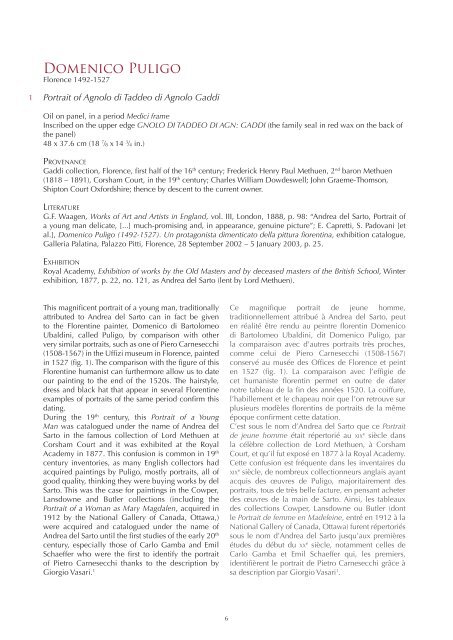XVII - Master Paintings - Jean Luc Baroni and Marty de Cambiaire
Create successful ePaper yourself
Turn your PDF publications into a flip-book with our unique Google optimized e-Paper software.
Domenico Puligo<br />
Florence 1492-1527<br />
1<br />
Portrait of Agnolo di Tad<strong>de</strong>o di Agnolo Gaddi<br />
Oil on panel, in a period Medici frame<br />
Inscribed on the upper edge GNOLO DI TADDEO DI AGN: GADDI (the family seal in red wax on the back of<br />
the panel)<br />
48 x 37.6 cm (18 7 ⁄8 x 14 3 ⁄4 in.)<br />
Provenance<br />
Gaddi collection, Florence, first half of the 16 th century; Fre<strong>de</strong>rick Henry Paul Methuen, 2 nd baron Methuen<br />
(1818 – 1891), Corsham Court, in the 19 th century; Charles William Dow<strong>de</strong>swell; John Graeme-Thomson,<br />
Shipton Court Oxfordshire; thence by <strong>de</strong>scent to the current owner.<br />
Literature<br />
G.F. Waagen, Works of Art <strong>and</strong> Artists in Engl<strong>and</strong>, vol. III, London, 1888, p. 98: “Andrea <strong>de</strong>l Sarto, Portrait of<br />
a young man <strong>de</strong>licate, [...] much-promising <strong>and</strong>, in appearance, genuine picture”; E. Capretti, S. Padovani [et<br />
al.], Domenico Puligo (1492-1527). Un protagonista dimenticato <strong>de</strong>lla pittura fiorentina, exhibition catalogue,<br />
Galleria Palatina, Palazzo Pitti, Florence, 28 September 2002 – 5 January 2003, p. 25.<br />
Exhibition<br />
Royal Aca<strong>de</strong>my, Exhibition of works by the Old <strong>Master</strong>s <strong>and</strong> by <strong>de</strong>ceased masters of the British School, Winter<br />
exhibition, 1877, p. 22, no. 121, as Andrea <strong>de</strong>l Sarto (lent by Lord Methuen).<br />
This magnificent portrait of a young man, traditionally<br />
attributed to Andrea <strong>de</strong>l Sarto can in fact be given<br />
to the Florentine painter, Domenico di Bartolomeo<br />
Ubaldini, called Puligo, by comparison with other<br />
very similar portraits, such as one of Piero Carnesecchi<br />
(1508-1567) in the Uffizi museum in Florence, painted<br />
in 1527 (fig. 1). The comparison with the figure of this<br />
Florentine humanist can furthermore allow us to date<br />
our painting to the end of the 1520s. The hairstyle,<br />
dress <strong>and</strong> black hat that appear in several Florentine<br />
examples of portraits of the same period confirm this<br />
dating.<br />
During the 19 th century, this Portrait of a Young<br />
Man was catalogued un<strong>de</strong>r the name of Andrea <strong>de</strong>l<br />
Sarto in the famous collection of Lord Methuen at<br />
Corsham Court <strong>and</strong> it was exhibited at the Royal<br />
Aca<strong>de</strong>my in 1877. This confusion is common in 19 th<br />
century inventories, as many English collectors had<br />
acquired paintings by Puligo, mostly portraits, all of<br />
good quality, thinking they were buying works by <strong>de</strong>l<br />
Sarto. This was the case for paintings in the Cowper,<br />
Lansdowne <strong>and</strong> Butler collections (including the<br />
Portrait of a Woman as Mary Magdalen, acquired in<br />
1912 by the National Gallery of Canada, Ottawa,)<br />
were acquired <strong>and</strong> catalogued un<strong>de</strong>r the name of<br />
Andrea <strong>de</strong>l Sarto until the first studies of the early 20 th<br />
century, especially those of Carlo Gamba <strong>and</strong> Emil<br />
Schaeffer who were the first to i<strong>de</strong>ntify the portrait<br />
of Pietro Carnesecchi thanks to the <strong>de</strong>scription by<br />
Giorgio Vasari. 1<br />
Ce magnifique portrait <strong>de</strong> jeune homme,<br />
traditionnellement attribué à Andrea <strong>de</strong>l Sarto, peut<br />
en réalité être rendu au peintre florentin Domenico<br />
di Bartolomeo Ubaldini, dit Domenico Puligo, par<br />
la comparaison avec d’autres portraits très proches,<br />
comme celui <strong>de</strong> Piero Carnesecchi (1508-1567)<br />
conservé au musée <strong>de</strong>s Offices <strong>de</strong> Florence et peint<br />
en 1527 (fig. 1). La comparaison avec l’effigie <strong>de</strong><br />
cet humaniste florentin permet en outre <strong>de</strong> dater<br />
notre tableau <strong>de</strong> la fin <strong>de</strong>s années 1520. La coiffure,<br />
l’habillement et le chapeau noir que l’on retrouve sur<br />
plusieurs modèles florentins <strong>de</strong> portraits <strong>de</strong> la même<br />
époque confirment cette datation.<br />
C’est sous le nom d’Andrea <strong>de</strong>l Sarto que ce Portrait<br />
<strong>de</strong> jeune homme était répertorié au xix e siècle dans<br />
la célèbre collection <strong>de</strong> Lord Methuen, à Corsham<br />
Court, et qu’il fut exposé en 1877 à la Royal Aca<strong>de</strong>my.<br />
Cette confusion est fréquente dans les inventaires du<br />
xix e siècle, <strong>de</strong> nombreux collectionneurs anglais ayant<br />
acquis <strong>de</strong>s œuvres <strong>de</strong> Puligo, majoritairement <strong>de</strong>s<br />
portraits, tous <strong>de</strong> très belle facture, en pensant acheter<br />
<strong>de</strong>s œuvres <strong>de</strong> la main <strong>de</strong> Sarto. Ainsi, les tableaux<br />
<strong>de</strong>s collections Cowper, Lansdowne ou Butler (dont<br />
le Portrait <strong>de</strong> femme en Ma<strong>de</strong>leine, entré en 1912 à la<br />
National Gallery of Canada, Ottawa) furent répertoriés<br />
sous le nom d’Andrea <strong>de</strong>l Sarto jusqu’aux premières<br />
étu<strong>de</strong>s du début du xx e siècle, notamment celles <strong>de</strong><br />
Carlo Gamba et Emil Schaeffer qui, les premiers,<br />
i<strong>de</strong>ntifièrent le portrait <strong>de</strong> Pietro Carnesecchi grâce à<br />
sa <strong>de</strong>scription par Giorgio Vasari 1 .<br />
6















